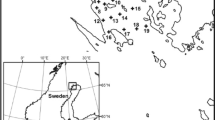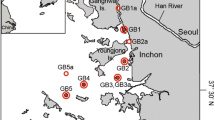Abstract
Bacterial growth efficiency (BGE) is a key factor in understanding bacterial influence on carbon flow in aquatic ecosystems. We report intra-annual variability in BGE, and bacteria-mediated carbon flow in the tropical Mandovi and Zuari estuaries (southwest India) and the adjoining coastal waters (Arabian Sea). BGE ranged from 3% to 61% and showed clear temporal variability with significantly (ANOVA, p < 0.01) higher values in the estuaries (mean, 28 ± 14%) than coastal waters (mean, 12 ± 6%). The greater variability of BGE in the estuaries than coastal waters suggest some systematic response to nutrient composition and the variability of dissolved organic matter pools, as BGE was governed by bacterial secondary production (BP). Monsoonal rains and its accompanied changes brought significant variability in BGE and bacterial productivity/primary productivity (BP/PP) ratio when compared to nonmonsoon seasons in the estuaries and coastal waters. High BP/PP ratio (>1) together with high carbon flux through bacteria (>100% of primary productivity) in the estuarine and coastal waters suggests that bacterioplankton consumed dissolved organic carbon in excess of the amount produced in situ by phytoplankton of this region, which led to the mismatch between primary production of carbon and amount of carbon consumed by bacteria. Despite the two systems being subsidized by allochthonous inputs, the low BGE in the coastal waters may be attributable to the nature and time interval in the supply of allochthonous carbon.


Similar content being viewed by others
References
Azam, F (1998) Microbial control of oceanic carbon flux: the plot thickens. Science 280: 694–696
Azam, F, Fenchel, F, Field, JG, Gray, JS, Meyer-Reil, LA, Thingstad, F (1983) The ecological role of water-column microbes in the sea. Mar Ecol Prog Ser 10: 257–263
Biddanda, B, Cotner, JB (2002) Love handles in aquatic ecosystems: the role of dissolved organic drawdown, resuspended sediments, and terrigenous inputs in the carbon balance of Lake Michigan. Ecosystems 5: 431–445
Briand, E, Pringault, Jacquet, S, Torreton, JP (2004) The use of oxygen microprobes to measure bacterial respiration for determining bacterioplankton growth efficiency. Limnol Oceanogr Methods 2: 406–416
Carignan, R, Blais, AM, Vis, C (1998) Measurement of primary production and community respiration in oligotrophic lakes using the Winkler method. Can J Fish Aquat Sci 55: 1078–1084
Carignan, R, Planas, D, Vis, C (2000) Planktonic production and respiration in oligotrophic lakes. Limnol Oceanogr 45: 189–1999
Carlson, CA, Ducklow, HW (1996) Growth of bacterioplankton and consumption of dissolved organic carbon in the Sargasso Sea. Aquat Microb Ecol 10: 69–85
Carpenter, JH (1965) The Chesapeake Bay Institute technique for the Winkler dissolved oxygen method. Limnol Oceanogr 10: 141–143
Chin-Leo, G, Kirchman, DL (1990) Unbalanced growth in natural assemblages of marine bacterioplankton. Mar Ecol Prog Ser 63: 1–8
Cole, JJ (1999) Aquatic microbiology for ecosystem scientists: new and recycled paradigms in ecological microbiology. Ecoystems 2: 215–225
Cole, JJ, Caraco, NF, Strayer, DI (1989) A detailed organic carbon budget as an ecosystem-level calibration of bacterial respiration in an oligotrophic lake during midsummer. Limnol Oceanogr 34: 287–296
Cole, JJ, Findlay, S, Pace, ML (1988) Bacterial production in fresh and salt-water ecosystems: a cross system overview. Mar Ecol Prog Ser 43: 1–10
Coveney, MF, Wetzel, RG (1995) Biomass, production and specific growth rate of bacterioplankton and coupling to phytoplankton in an oligotrophic lake. Limnol Oceanogr 40: 1187–1200
Day, JW Jr, Hall, CAS, Kemp, WM, Yanez-Arancibia, A (1989) Estuarine Ecology. Wiley, New York
del Giorgio, PA, Cole, JJ (1998) Bacterial growth efficiency in natural aquatic ecosystems. Annu Rev Ecol Syst 29: 503–541
del Giorgio, PA, Cole, JJ (2000) Bacterial energetics and growth efficiency. In: Kirchman DL (Ed.) Microbial Ecology of the Oceans. Wiley-Liss, New York, pp 289–325
del Giorgio, PA, Cole, JJ, Cimbleris, A (1997) Respiration rates in bacterial exceed phytoplankton production in unproductive aquatic systems. Nature 385: 148–151
Ducklow, HW, Carlson, CG (1992) Oceanic bacterial production. Adv Microb Ecol 12: 113–180
Findlay, S, Pace, ML, Lints, D, Cole, J, Caraco, NF, Peierls, B (1991) Weak coupling of bacterial and algal production in a heterotrophic ecosystem: the Hudson River estuary. Limnol Oceanogr 36: 268–278
Fuhrman, JA, Azam, F (1982) Thymidine incorporation as a measure of heterotrophic bacterioplankton production in marine surface waters: evaluation and field results. Mar Biol 66: 109–120
Gattuso, JP, Frankignoulle, M, Wollast, R (1998) Carbon and carbonate metabolism in coastal aquatic ecosystems. Annu Rev Ecol Syst 29: 405–434
Gattuso, JP, Peduzzi, S, Pizay, MD, Tonolla, M (2002) Changes in freshwater bacterial community composition during measurements of microbial and community respiration. J Plank Res 24: 1197–1206
Goldman, JC, Dennett, MR (2000) Growth of marine bacteria in batch and continuous culture under carbon and nitrogen limitation. Limnol Oceanogr 45: 789–800
Goosen, NK, Pieter, van Rijswijk, Kromkamp, J, Peene, J (1997) Regulation of annual variation in heterotrophic bacterial production in the Schelde estuary (SW Netherlands). Aquat Microb Ecol 12: 223–232
Hart, DR, Stone, L, Berman, T (2000) Seasonal dynamics of the Lake Kinneret food web: the importance of the microbial loop. Limnol Oceanogr 45: 350–361
Hoch, MP, Kirchman, DL (1993) Seasonal and inter-annual variability in bacterial production and biomass in a temperate estuary. Mar Ecol Prog Ser 98: 283–295
Lee, S, Fuhrman, JA (1987) Relationships between biovolume and biomass of naturally derived marine bacterioplankton. Appl Environ Microbiol 53: 1298–1303
Lohrenz, SE, Wiesenburg, DA, Rein, CR, Arnone, RA, Taylor, CD, Knauer GA, Knap, AHA (1992) A comparison of in situ and simulated in situ methods for estimating oceanic primary production. J Plankton Res 14: 201–221
Madhupratap, M, Kumar, SP, Bhattathiri, PMA, Dileep Kumar, M, Raghukumar, S, Nair, KKC, Ramaiah, N (1996) Mechanism of the biological response to winter cooling in the northeastern Arabian Sea. Nature 384: 549–552
Massana, R, Pedros-Alio, C, Casamayor, EO, Gasol, JM (2001) Changes in marine bacterioplankton phylogenetic composition during incubations designed to measure biogeochemically significant parameters. Limnol Oceanogr 46: 1181–1188
Moran, MA, Hodson, RE (1990) Bacterial production on humic and nonhumic components of dissolved organic carbon. Limnol Oceanogr 35: 1744–1756
Owens, NJP (1986) Estuarine nitrification: a naturally occurring fluidized bed reaction? Estuar Coast Shelf Sci 21: 711–725
Packard, TT (1971) The measurements of respiratory electron transport activity in marine phytoplankton. J Mar Res 29: 235–244
Pakulski, JD, Benner, R, Amon, R, Eadie, B, Whitledge, T (1995) Community metabolism and nutrient cycling in the Mississippi River Plume—evidence for intense nitrification at intermediate salinities. Mar Ecol Prog Ser 117: 207–218
Parsons, TR, Maita, Y, Lalli CM (1984) A manual of chemical and biological methods for seawater analysis. Permagon, Oxford
Pomeroy, LR, Wiebe, WJ, Deibel, D, Thompon, RJ, Rowe, GT, Pakulski, JD (1994) Changes in bacterial numbers and leucine assimilation during estimations of microbial respiratory rates in seawater by precision Winkler method. Appl Environ Microbiol 60: 328–332
Preen, K, Kirchman, DL (2004) Microbial respiration and production in the Delaware estuary. Aquat Microb Ecol 37: 109–119
Qasim, SZ, Sengupta, R (1981) Environmental characteristics of the Mandovi–Zuari estuarine system in Goa. Estuar Coast Shelf Sci 13: 557–578
Ram, ASP, Nair, S, Chandramohan, D (2003) Bacterial growth efficiency in the tropical estuarine and coastal waters of Goa, southwest coast of India. Microb Ecol 45: 88–96
Ram, ASP, Nair, S, Chandramohan, D (2003) Seasonal shift in net ecosystem production in a tropical estuary. Limnol Oceanogr 48: 1601–1607
Revilla, M, Iriarte, A, Madariaga, I, Orive, E (2000) Bacterial and phytoplankton dynamics along a trophic gradient in a shallow temperate estuary. Estuar Coast Shelf Sci 50: 297–313
Roland, F, Cole, JJ (1999) Regulation of bacterial growth efficiency in a large turbid estuary. Aquat Microb Ecol 20: 31–38
Sugimura, Y, Suzuki, Y (1988) A high temperature catalytic oxidation method of non-volatile dissolved organic carbon in sea water by direct injection of a liquid sample. Mar Chem 24: 105–131
Tranvik, LJ (1992) Allochthonous dissolved organic matter as an energy source for pelagic bacteria and the concept of the microbial loop. Hydrobiologia 229: 107–114
Unnikrishnan, AS, Shetye, SR, Gouveia, AD (1997) Tidal propagation in the Mandovi–Zuari estuarine network, west coast of India: impact of freshwater influx. Mar Ecol Prog Ser 45: 737–744
Acknowledgments
We thank Dr. D. L. Kirchman (University of Delaware), Dr. B. Biddanda (Grand Valley State University, USA), Dr. K. Kogure (Ocean Research Institute, University of Tokyo, Japan), and Dr. T. Nagata (Centre for Ecological Research, Kyoto University, Japan) for their valuable comments and suggestions. This research was supported by the grant from the Office of Naval Research (USA) under the Indo-US collaborative project on Trophic Dynamics. ASP is supported by a Senior Research Fellowship grant from the Council of Scientific and Industrial Research (CSIR), New Delhi. NIO contribution no. 4150
Author information
Authors and Affiliations
Corresponding author
Rights and permissions
About this article
Cite this article
Pradeep Ram, A.S., Nair, S. & Chandramohan, D. Bacterial Growth Efficiency in a Tropical Estuary: Seasonal Variability Subsidized by Allochthonous Carbon. Microb Ecol 53, 591–599 (2007). https://doi.org/10.1007/s00248-006-9124-y
Received:
Accepted:
Published:
Issue Date:
DOI: https://doi.org/10.1007/s00248-006-9124-y




